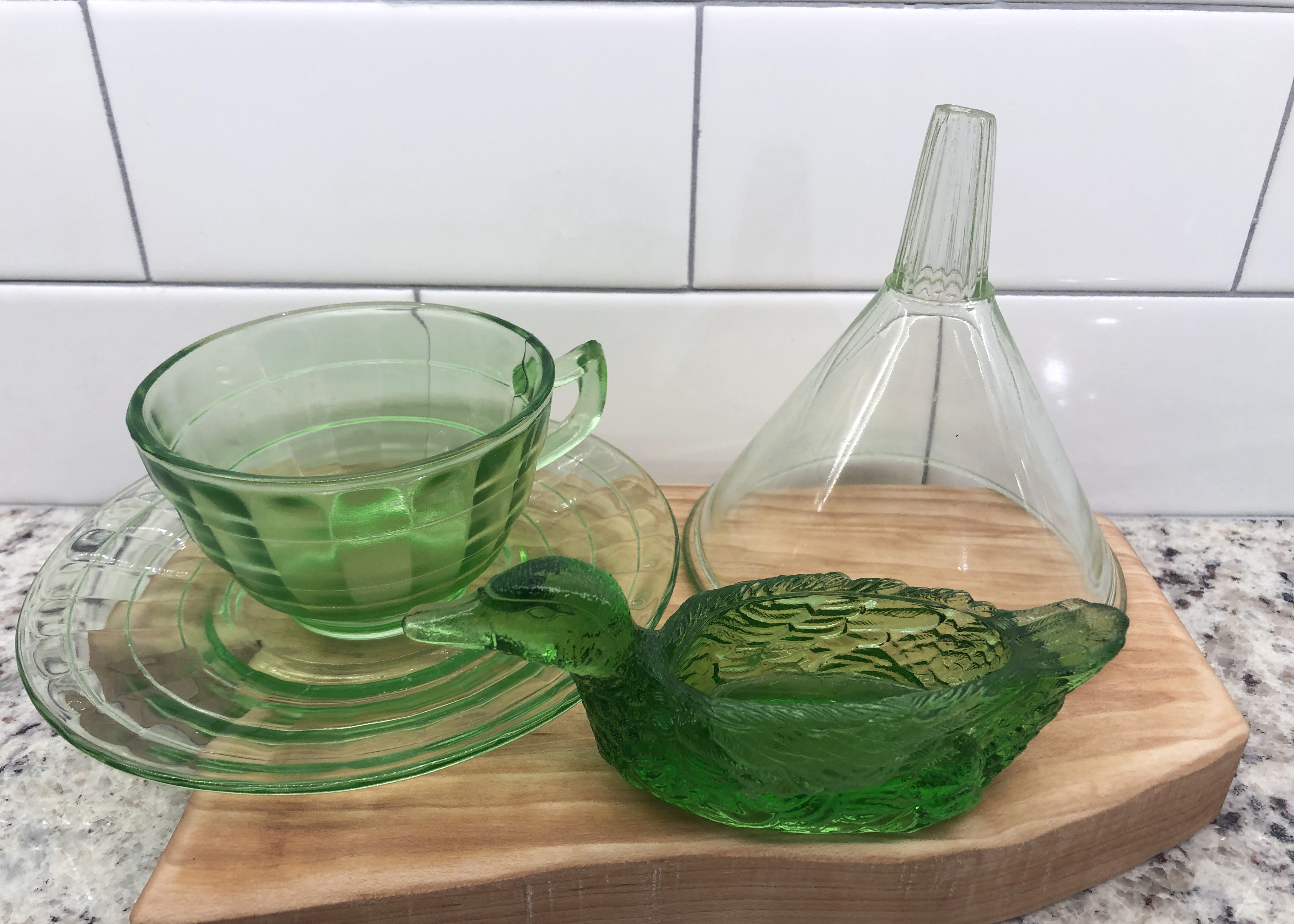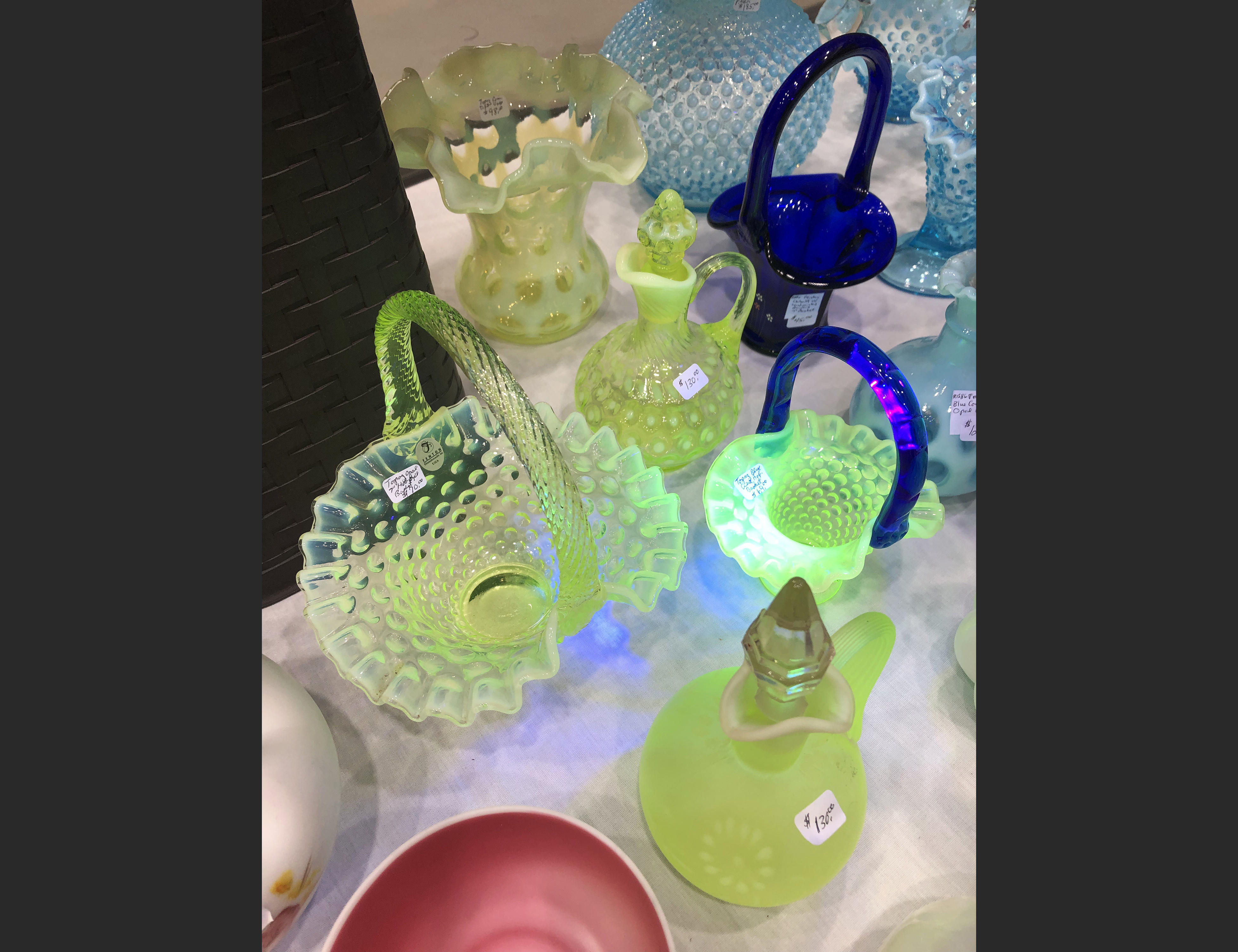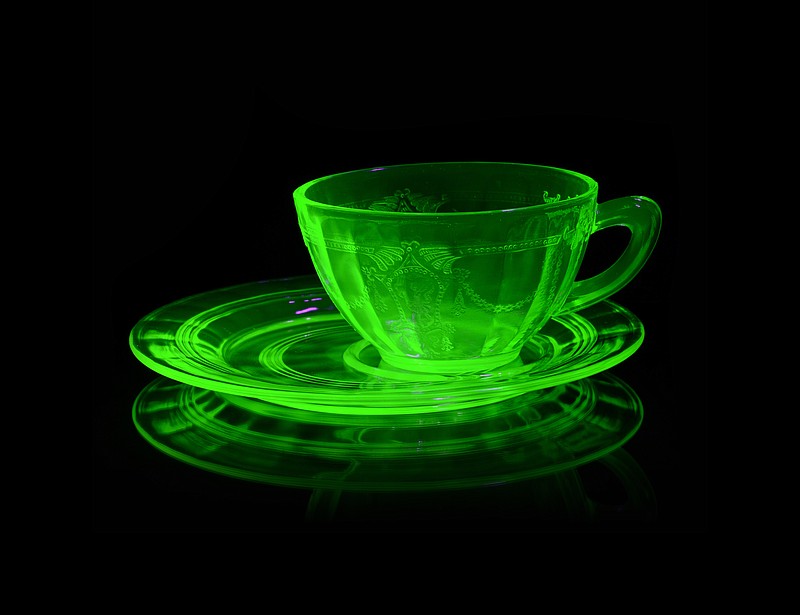While roaming my favorite antique store outside Atlanta recently, I heard a "click click" sound and turned around to see a woman shining a black-light flashlight on a green plate. A few minutes later, a man joined her with a black box that began to hum when it got close to the plate. It was the unmistakable sound of a Geiger counter, a tool used to detect radioactivity. As was I, they were in search of a specific kind of vintage treasure: the green glow of uranium glass.
Although uranium is often associated with atomic bombs and nuclear disasters, for much of its history, it was just another coloring agent. German chemist Martin Heinrich Klaproth discovered the element in 1789, and glassmakers later began using it to color glass in shades ranging from bright green to pale yellow.
The term "uranium glass" generally describes glass with uranium oxide, which glows under a black light. Other terms — Vaseline glass and Depression glass, for example — came later and apply more specifically to lighter yellow glass and glass made during the Great Depression, respectively. By any name, though, it's experiencing a renewed popularity among collectors who are drawn to its eerie glow and perceived danger. TikTok has increased its visibility in recent years, with accounts such as terrestrialtreasures sharing finds to more than 77,000 followers.
Whitney Granger, a collector and the owner of StoryShapedStudios on Etsy, learned about uranium glass in the Facebook group Weird (and Wonderful) Secondhand Finds That Just Need to Be Shared.
"I had no room for curio cabinets to collect uranium glassware," she says. "However, I was at the time very interested in vintage jewelry, and when I saw my first piece of uranium glass jewelry, I was immediately hooked."
That piece was a 1920s pressed glass beaded flapper necklace made by the Neiger brothers in pre-World War II Czechoslovakia. "They are considered among the greatest Czech jewelry designers in history and frequently used uranium glass," Granger says.
 Caroline Eubanks' collection of uranium glass includes a teacup and saucer, a funnel and a duck-shaped salt cellar. (Photo by Caroline Eubanks via The Washington Post)
Caroline Eubanks' collection of uranium glass includes a teacup and saucer, a funnel and a duck-shaped salt cellar. (Photo by Caroline Eubanks via The Washington Post)
ONE OF THE FIRST
Franz Anton Riedel is cited as one of the first to add uranium to glass, using it in the 1830s in the modern-day Czech Republic, but similar work was going on simultaneously in the United States, England and other locations. A set of uranium glassware was created for the accession of Queen Victoria in 1837. And Fenton, Fostoria and Cambridge glass, which can be found in antique stores, were being manufactured in the United States in the late 19th and early 20th centuries.
The process isn't too different from making other types of glass.
"Most tableware kind of glass is what's called a soda-lime glass," says Katherine Gray, a glass artist and judge on Netflix's "Blown Away." The base is mostly silica, with a few "fluxes," or substances that lower the melting point of the silica, she adds. Color is added by inserting pieces from long rods of tinted glass in the hot blow pipe, or by rolling molten glass in a fine powder of a metal oxide, including uranium.
"Uranium is just a controlled substance, so it's a little harder to get your hands on, ... but there are a few people that manufacture it in the U.S.," says Gray, who has created pieces of uranium glass for items she sells under her "Hearth" series.
The style of glass waned in popularity during World War II and the postwar era, when uranium was highly regulated, because it was needed for the war effort. In 1958, though, it was deregulated. When they began producing the glass again, the uranium was depleted, meaning its radioactivity was significantly lower than natural uranium. It retains its glow, though. Earlier pieces tend to be rarer and more valuable.
 Fenton is one of the popular creators of uranium glass, especially in the hobnail design. (Photo by Caroline Eubanks via The Washington Post)
Fenton is one of the popular creators of uranium glass, especially in the hobnail design. (Photo by Caroline Eubanks via The Washington Post)
OTHER COLORING AGENTS
About 4 million pieces, including drinking glasses and decorative items, were manufactured in the United States between 1958 and 1978, according to Oak Ridge Associated Universities. After this period, glassmakers increasingly turned to other coloring agents that were easier to source, but some, such as Gray, continue to make items using uranium glass.
But is the glass safe? Some items do emit small amounts of radiation, according to the Environmental Protection Agency. The level of radioactivity varies by piece, ranging from less than 1% to up to 25% by weight, but there is no recognized danger to handling or using uranium glass, according to the U.S. Nuclear Regulatory Commission. A 2008 study from Nova University Lisbon determined that the radiation levels in uranium glass are comparable to those from many everyday activities, such as air travel or cellphone use. Eating off uranium glass poses minimal risks, according to Paul W. Frame, a senior health physicist at Oak Ridge Associated Universities, and no special treatment is required when disposing of it.
"You're dealing with chemically purified uranium [in uranium glass]," Frame says. "Uranium that has been chemically purified is generally not that much of a risk. It's not particularly radioactive." This type of uranium, which hasn't been enriched like the type used for nuclear weapons, has a fraction of the amount of radioactivity, according to the International Atomic Energy Agency.
Aspiring collectors don't need to go far to find uranium glass; it's not uncommon to come across it in stores that sell antiques and other secondhand items. Pieces are also available from online sellers on Etsy and eBay, typically with photos highlighting their fluorescence. Depression glass clubs across the country, including the National Depression Glass Association, also have shows where you can buy from experts.
Here are some tips for starting a collection:
◼️ Take a light. First-time uranium glass hunters should come prepared with a black-light flashlight or Geiger counter to ensure the glass is legitimate. Not everything that glows is uranium — some red/orange-hued glass is made with manganese, for example — but uranium generally glows. More experienced collectors might recognize the particular tint of uranium glass by sight without a UV light to confirm.
◼️ "Make sure the item is actually glass," Granger says. "If the item is glass, and fluoresces neon green under a black light, it contains uranium dioxide 100% of the time."
◼️ Look deeper. Not all items are bright green; other colors include yellow and amber. And uranium glass isn't limited to drinkware and plates. Look for decorative sugar dishes, mixing bowls and lamps. I've even found a uranium glass fishbowl.
◼️ Prepare to pay. Prices vary based on the seller and the rarity of the item, with big-name brands such as Fenton and Anchor Hocking being more expensive. Glass shows tend to value pieces accordingly, but you might find deals at smaller stores. To be sure of an item's value, use Replacements, Ltd. and books such as "Miller's Collectibles Handbook & Price Guide."
◼️ Display it proudly. Buy a black-light strip with a battery pack that you can place inside a cabinet to show off your glowing treasures. If you're tight on space, opt for jewelry, as Granger did, or other tiny items, such as salt and pepper shakers.
